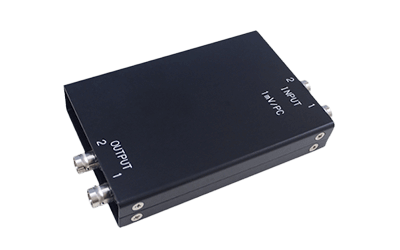What Is a Charge Amplifier?

A charge amplifier is an amplifier that converts a very small charge signal generated by a piezoelectric sensor, which is difficult to measure, into a proportional voltage signal.
Since the charge signal generated by a piezoelectric sensor is precisely proportional to the pressure applied to the piezoelectric sensor, it is very useful to accurately measure this value. Charge amplifiers can convert the charge signal generated by a pressure sensor into a voltage that is exactly proportional to the charge.
Uses of Charge Amplifiers
1. Amplification of Piezoelectric Sensors
Charge amplifiers are used to make measurements with piezoelectric sensors. Charge amplifiers are used when piezoelectric sensors are installed in confined spaces or in environments with high ambient temperatures. This is because piezoelectric sensors are small in size, some of them feature high heat resistance, and are often used for measurement in the above environments.
Charge amplifiers are also ideal for measurements that require responsiveness. Piezoelectric sensors measure minute displacements and can produce highly synthetic sensors. They are used to amplify the measured minute displacement with a charge amplifier. 2.
2. Others
They are widely used in instruments that measure ionizing radiation, such as proportional counters and scintillation counters. These instruments detect radiation in ionizing phenomena and measure the energy of each pulse.
Charge amplifiers can be used to convert the charge pulses from the detector into a voltage output, allowing measurement of each individual pulse.
Principle of Charge Amplifiers
As already mentioned, piezoelectric sensors generate a minute electric charge when pressure is applied. The role of the charge amplifier is to convert this small charge into a voltage that can be measured.
1. Charge Conversion
Charge amplifiers convert the negative charge output proportional to the pressure applied by the piezoelectric sensor into a positive proportional voltage. In modern charge amplifiers, this signal can be used directly in digital form.
By converting the charge into a voltage signal, it becomes a signal that can be input to a measuring instrument (DAQ, FFT analyzer, oscilloscope, etc.) that processes the data.
2. Amplification Mechanism
An integrating amplifier is used when the charge amplifier converts a small charge to a voltage. If the capacitance of the integrating amplifier’s capacitor is Cg and the charge of a small charge is Q, the voltage V is obtained by V = Q / Cg.
The configuration of the charge amplifier’s integrating amplifier is a circuit consisting of an operational amplifier and a capacitor. The current entering the capacitor is time integrated, and the circuit amplifies the charge.
All the input charge is charged to the capacitor. A similar circuit to the charge amplifier’s integrating amplifier is the integrating circuit. This is a circuit with a resistor, a current-to-voltage conversion circuit, at the input. It has the feature of time-integrating and amplifying voltage.
3. Noise Rejection and Protection Function
The charge amplifier has a high-pass filter and a low-pass filter at the output points to eliminate noise. In some cases, a resistor is attached to the input of the amplifier circuit of the charge amplifier. That resistor is not intended for current/voltage conversion, but for protection against excessive input signals.
How to Select a Charge Amplifier
In practice, it is very important to select a charge amplifier that is appropriate for the measurement target in order to make accurate measurements. In selecting a charge amplifier, the following are important aspects to consider
1. Number of Measurement Channels
If there are multiple measurement points, measurement cannot be performed without multiple measurement channels. If the number of measurement channels is insufficient, measurement can of course be performed by purchasing more charge amplifiers, but this is less advantageous due to the higher cost and more complicated adjustment work.
2. Size of Input Charge Signal
It is also important to determine whether the piezoelectric sensor is compatible with large and small charge signals. Naturally, measurements cannot be made unless the measurement ranges match, but it is necessary to introduce charge amplifiers with a measurement range that is in line with future measurement plans.